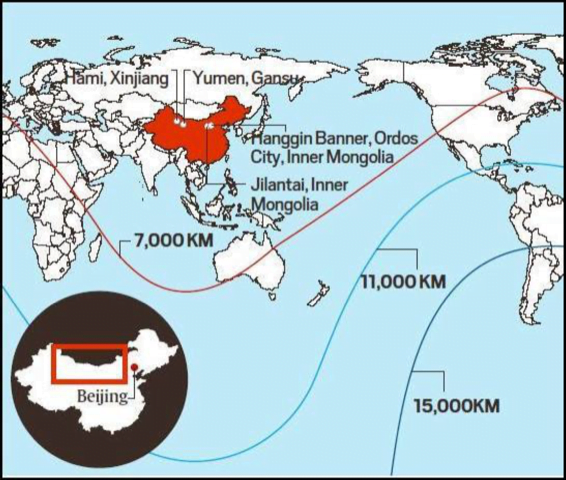UPSC Articles
INTERNATIONAL/SECURITY
- GS-2: India and its neighborhood- relations.
- GS-3: Security challenges and their management in border areas
China’s Missile Silos
Context: Satellite images have revealed that China is building at least three missile silo fields in Gansu province, in Xinjiang province, and at Hanggin Banner, Ordos City, in Inner Mongolia.
- Some of the silos have dome shelters
- Earlier this year, missile silos were detected in the People’s Liberation Army Rocket Force’s (PLARF) Jilantai training area, also in Inner Mongolia.
- These missile silos have been identified by US satellite images obtained by the Federation of American Scientists.
- For several decades before these discoveries in 2021, China operated only 20 missile silos for its DF-5 liquid-fuel intercontinental ballistic missile (ICBM).
- On completion of the ongoing work, China could have 250-270 new missile silos, more than 10 times the number it had maintained for several decades.

Why is China building missile silos?
There could be three explanations.
FIRST, some believe this could be China’s attempt to move towards a launch-on-warning (LOW) nuclear posture.
- LOW refers to a launch at an adversary on detection of an incoming missile before the adversary’s missile hits its target.
- It is based on achieving deterrence through assured retaliation.
- In order to move to the LOW posture, China would have to mate a few warheads with missiles, and keep them in alert status for a quick response.
- Currently, China stores its warheads and missiles in a de-alerted status separately under different commands.
- However, silos alone, at such an early stage of construction, are not conclusive evidence of China’s move to LOW.
SECOND, it enables China to achieve its goal of increasing its nuclear warhead stockpile.
- China currently has around 350 nuclear warheads.
- 272 of these 350 warheads are assigned to operational forces; the remaining 78 have been produced for China’s new DF-41 solid-fuel road-mobile ICBM.
- China has around 150 land-based missiles that can deliver between 180-190 nuclear warheads to some parts of the United States.
- If all the new silos are loaded with a single-warhead missile, the count would increase to 410-440.
- If the silos on completion are loaded with the DF-41s, which can carry up to two-three warheads per missile, this count would rise to 930-940 warheads.
The THIRD guess is that China could use these silos as decoys.
- The recently discovered silos could be an initiative to enhance deterrence by keeping the adversary guessing.
- This could be China’s shell game — where one, some, or all silos could have missiles, forcing the aggressor to target all of them during an escalation.
- The aggressor would have to waste more warheads or precision-guided weapons to destroy only a few missiles, or perhaps target empty silos.
- This would be a cost-effective strategy for China, and could also bolster its image as serious nuclear power and an equal to the US.
How has the US reacted to the discovery of the silos?
- US has noted that the PRC’s nuclear arsenal will grow more quickly, and to a higher level than perhaps previously anticipated.
- US noted that this buildup is concerning which raises questions about the PRC’s intent.
- China’s reaction to US
-
- Neither the Chinese Ministry of Foreign Affairs nor the Ministry of National Defence has reacted.
- Some Chinese media have said the silos are wind farms, and accused American academics and journalists of spreading a “China threat theory”.
So should India be concerned?
- Seen in isolation, these silos appear to be built specifically to enhance deterrence against the US.
- But broadly, India should be watchful about China’s nuclear ambiguity and its latest DF-26 intermediate-range road-mobile dual-use missiles — of which 16 launchers were deployed in Korla, Xinjiang, during the ongoing standoff.
- India could be a potential target given the strike ranges of these missiles and the timing of deployment.
- Although both China and India have pledged nuclear ‘no first use’ doctrines, India’s modest ballistic missile defence capabilities and China’s nuclear ambiguity are matters of concern for India.
What should the world do about these developments?
- There isn’t an obvious option for the US or world.
- China has stated that it will not join the NEW START (Strategic Arms Reduction Treaty). China has said that the US and Russia have almost 20 times more nuclear warheads than China, and that “It is unrealistic to expect China to join the two countries in a negotiation aimed at nuclear arms reduction.”
- Several American arms control scholars have argued for a renewal of the US government-funded US-China track 1.5 nuclear dialogue that was suspended after 15 years in 2019 due to growing friction, “declining value”, and the failure to launch track 1 dialogue.
- Others have said that the US’s newer missile defence capabilities disturb strategic stability and complicate arms control.
Connecting the dots:
- India’s Nuclear Doctrine
- India-China: Lessons from Ladakh Stand-off
- Nuclear Non-proliferation Treaty














